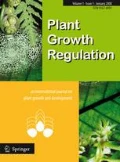Abstract
1-Methylcyclopropene (1-MCP), a competitive inhibitorof ethylene action, binds to the ethylene receptor toregulate tissue responses to ethylene. In this work,we investigated the effects of 1-MCP and exogenousethylene on ripening, respiration rate, ionicconductivity and peroxidase activity in strawberryfruit. Strawberry fruit can ripen without exogenousethylene treatment, but exogenous ethylene inducessecondary ripening processes. Results indicated thatstimulation of respiration by ethylene wasdose-dependent. Fruit colour development and softeningwere slightly accelerated by ethylene, but changes insoluble solid content were not. 1-MCP may/may notaffect the respiratory rise induced by exogenousethylene dependent on fruit maturity. Cycloheximide(CHI) reduced the ethylene-induced respiratoryincrease. Combinations of 1-MCP and CHI reducedrespiration more than CHI alone. 1-MCP and CHI did notinfluence the primary respiratory change in nonethylene-treated fruit. This indicates that ethyleneinduced respiratory increase may involve an ethylenereceptor in early harvested fruit, but not in laterharvested fruit. Exogenous ethylene stimulatedrespiration by regulating new respiratory enzyme(s)synthesis in strawberry fruit. Ethylene induced anionic leakage increase, and this was positivelycorrelated to fruit water loss and peroxidaseactivity. These results suggest that non-climactericfruit, such as strawberry, may have different ethylenereceptor(s) and/or ethylene receptor(s) may havedifferent regulatory functions. It may be thesecondary effect of ethylene to stimulate respirationin strawberry. Non-climacteric fruit ripening may berelated to the development of active oxygen species(AOS) induced by postharvest stress.
Similar content being viewed by others
References
Abeles FB (1973) Ethylene in plant biology. New York: Academic Press
Chang, C, Kwok, SF, Bleeker, AB, Meyerowiltz EM (1993) Arobidopsis ethylene-response gene ETR1: similarity of product to two-component regulators. Science 262: 539–544
Civello PM, Martinez GA and Chaves AR and Anon MC (1995) Peroxidase from strawberry fruit (Fragaria ananassa Duch.) partial purification and determination of some properties. J Agri Food Chem 43: 2596–2601
El-Kazzaz MK, Sommer NF and Fortlage RJ (1983) Effect of different atmospheres on postharvest decay and quality of fresh strawberries. Phytopathology 73: 282–285
Foyer CH, Descourvieres P and Kunert KJ (1994) Protection against oxygen radicals: an important defence mechanism studied in transgenic plants. Plant, Cell and Environment 17: 507–523
Janes HW, Chin CK and Frankle C (1978) Respiratory upsurge in blueberries and strawberries as influenced by ethylene and acetaldehyde. Bot Gaz 139: 50–52
Kumi Sato-Nara, Ken-Ichi Yuhashi, Katsumi Higashi, Kazushige Hosoya, Mitsuru Kubota and Hiroshi Ezura (1999) Stage-and tissue-specific expression of ethylene receptor homolog genes during development in mushmelon. Plant Physiol 119: 321–329
Nam Y-W, Line T, Monique L, Blondine C, Isabelle M and Jean-Marc L (1999) Isoltion and characterization of mRNAs differentially expressed during ripening of wild strawberry (Fragaria vesca L.) fruits. Plant Mol Bil 39: 629–636
Serek M, Sisler EC and Reid M (1994) Novel gaseous ethylene inhibitor prevents ethylene effects in potted flowering plants. J Amer Soc Hort Sci 119: 1230–1233
Serek M, Sisler EC and Reid MS (1995a) 1-Methylcyclopropene, a novel gaseous inhibitor of ethylene action, improves the life of fruits, cut flowers and potted plants. Acta Hort 394: 337–345
Serek M, Sisler EC and Reid MS (1995b) Effects of 1-MCP on the vase life and ethylene response of cut flowers. Plant Growth Regulation 16: 93–97
Serek M, Tamari G, Sisler EC and Borochov A (1995c) Inhibition of ethylene-induced cellular senescence symptoms by 1-methylcyclopropene, a new inhibitor of ethylene action. Physiol Plant 94: 229–232
Schaller GE, Ladd AN, Lanahan MB, Spanbauer JM and Bleeker AB (1995) The ethylene response mediator ETR1 from Arabidopsis forms a disulfide-linked dimer. J Biol Chem 270: 12526–12530
Sisler EC (1991) Ethylene-binding components in plants. In: Mattoo AK and Suttle JC (eds) The Plant Hormone Ethylene. CRC Press, Boca Raton, Florida, USA. ISBN 0–8493–4566–9, pp 81–99
Sisler EC and Serek M (1997) Inhibitors of ethylene responses in plants at the receptor level: recent developments. Physiol Plant 100: 577–582
Song J, Tian MS, Dilley DR and Beaudry RM (1997) Effects of 1-MCP on apple fruit ripening and volatile production. ASHS Ann Meeting 23–28 July, 1997, University of California, USA.
Lee Soon A, Ross GS and Gardner RC (1998) An apple (Malus domestica L. Borkh cv Granny smith) homologue of the ethylene receptor gene ETR1 (Accession No. AF032448). (PGR98–125) Plant Physiol 117: 1125
Tian MS, Bowen JH, Bauchot AD, Gong YP and Lallu N (1997a) Recovery of ethylene biosynthesis in diazocyclopentadiene (DACP)-treated tomato fruit. Plant Growth Regulation 22: 73–78
Tian MS, Gong YP and Bauchot AD (1997b) Ethylene biosynthesis and respiration in strawberry fruit treated with diazocyclopentadiene and IAA. Plant Growth Regulation 23: 195–200
Tieman DM and Klee HJ (1999) Differential expression of two novel mambers of the tomato ethylene-receptor family. Plant Physio 120: 165–172
Wilkinson JQ, Lanahan MB, Conner TW and Klee HJ (1995) Identification of mRNAs with enhanced expression in ripening strawberry fruit using polymerase chain reaction differential display. Plant Mol Biol 27: 1097–1108
Wills RBH and Kim GH (1995a) Effect of ethylene on postharvest life of strawberries. Postharvest Biol Technol 6: 249–255
Wills RBH and Kim GH (1995b) Effect of ethylene synthesis in fruit ripening. In: Thomson WW, Nothnagel EA and Huffaker RC (eds) Plant Senescence: Its Biochemistry and Physiology. The American Society of Plant Physiologists, pp 156–166
Yang SF (1987) The role of ethylene and ethylene synthesis in fruit ripening. In: Thomson WW, Nothnagel EA and Huffaker RC (eds) Plant Senescence: Its Biochemistry and Physiology. The American Society of Plant Physiologists, pp 156–166
Author information
Authors and Affiliations
Rights and permissions
About this article
Cite this article
Tian, M., Prakash, S., Elgar, H. et al. Responses of strawberry fruit to 1-Methylcyclopropene (1-MCP) and ethylene. Plant Growth Regulation 32, 83–90 (2000). https://doi.org/10.1023/A:1006409719333
Issue Date:
DOI: https://doi.org/10.1023/A:1006409719333




